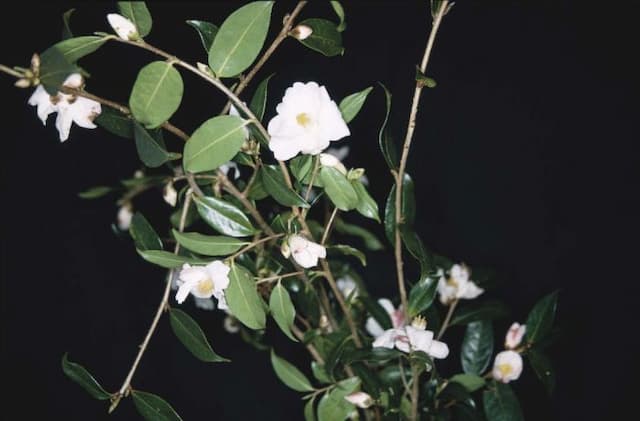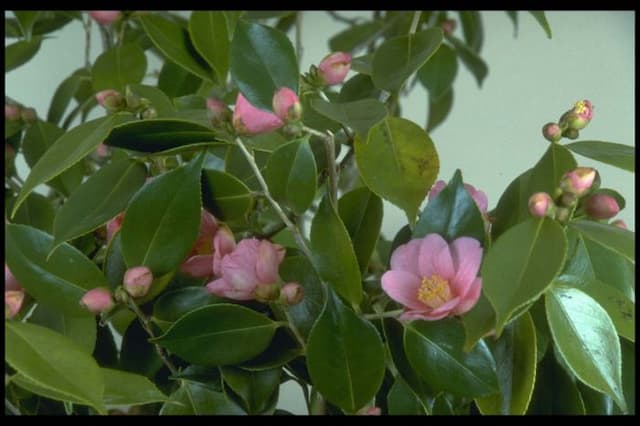Williamsii Camellia Camellia × williamsii 'China Clay'

ABOUT
The Camellia 'China Clay' is a striking ornamental shrub known for its gorgeous floral display and lush, glossy foliage. The leaves are deep green, oval-shaped, and have a leathery texture, creating a dense and evergreen backdrop for its flowers. The blooms are particularly noteworthy, featuring delicate, intricately arranged petals that range in color from a soft, creamy white to a pale, almost translucent hue. The flowers exude a subtle elegance and can often be comprised of several layers of petals, giving them a ruffled appearance that adds to their charm. These flowers can be quite showy, with centers that are typically adorned with an array of contrasting golden yellow stamens, highlighting the plant's natural beauty and drawing in pollinators. The blooms generally emerge in the late winter to early spring, providing a splendid display when many other plants are still dormant. Overall, the Camellia 'China Clay' is a captivating plant that adds a touch of refinement and beauty to any garden or landscape where it is grown, minus the factors of its physical size.
About this plant
 Names
NamesFamily
Theaceae
Synonyms
China Clay Camellia
Common names
Camellia × williamsii 'China Clay'.
 Toxicity
ToxicityTo humans
The plant commonly known as Williamsii Camellia is generally not considered toxic to humans. There is no significant evidence to suggest that it contains toxins that would cause poisoning if ingested. Consequently, there typically aren't any symptoms of poisoning associated with this plant, and the ingestion of its parts is not expected to produce harmful consequences.
To pets
Williamsii Camellia is also generally considered non-toxic to pets like dogs and cats. Much like with humans, there is no widely recognized evidence of toxicity causing symptoms of poisoning in pets, thus ingestion of this plant is not seen as presenting a significant health risk for animals.
 Characteristics
CharacteristicsLife cycle
Perennials
Foliage type
Evergreen
Color of leaves
Green
Flower color
White
Height
6-10 feet (1.8-3 meters)
Spread
5-8 feet (1.5-2.4 meters)
Plant type
Shrub
Hardiness zones
7
Native area
Asia
Benefits
 General Benefits
General Benefits- Ornamental Appeal: The plant has attractive, showy flowers that enhance the aesthetics of gardens and landscapes.
- Durability: Camellia × williamsii 'China Clay' is a hardy plant that can withstand cooler climates and is relatively disease-resistant.
- Year-Round Interest: With its dark green, glossy evergreen leaves, it provides visual interest throughout the year, even when not in bloom.
- Low Maintenance: It requires minimal pruning and upkeep once established, making it a suitable choice for both novice and experienced gardeners.
- Privacy Screening: When planted in groups or as a hedge, it can provide privacy due to its dense foliage.
- Wildlife Support: The flowers can attract pollinators such as bees and sometimes hummingbirds, supporting local biodiversity.
- Versatility: Suitable for various landscaping uses including borders, specimen planting, or container growing.
- Cultural Symbolism: Camellias have symbolic meanings in many cultures, often representing love, adoration, and admiration.
 Medical Properties
Medical PropertiesThis plant is not used for medical purposes.
 Air-purifying Qualities
Air-purifying QualitiesThis plant is not specifically known for air purifying qualities.
 Other Uses
Other Uses- Camellia × williamsii 'China Clay' can be used as a natural dye for textiles, providing a range of soft, warm hues depending on the processing method.
- The petals of the Camellia can be crystallized and used as edible decorations for cakes and desserts.
- Dried Camellia petals can be incorporated into handmade papers, adding a touch of elegance to the final product.
- Leaves of the Camellia plant can be used in the process of marbling paper, contributing to the unique patterns and designs.
- The oil extracted from the seeds of the Camellia can be used in woodworking to condition and protect wooden tools and surfaces.
- Camellia petals can serve as a natural confetti at weddings or celebrations, which is biodegradable and environmentally friendly.
- The strong, flexible branches of the Camellia can be used in basket-weaving or as supportive structures in floral arrangements.
- Dried and pressed Camellia flowers can be used in scrapbooking or as embellishments in other crafts such as card making.
- Camellia leaves can be used as a natural mulch in gardens, helping to retain moisture in the soil and suppress weeds.
- Camellia blossoms can be floated in bowls of water to create simple, yet elegant, table centerpieces for events and home decoration.
Interesting Facts
 Feng Shui
Feng ShuiThe Camellia is not used in Feng Shui practice.
 Zodiac Sign Compitability
Zodiac Sign CompitabilityThe Camellia is not used in astrology practice.
 Plant Symbolism
Plant Symbolism- Adoration: The Camellia typically symbolizes adoration, reflecting the beauty and perfection of its bloom that admirers often fawn over.
- Perfection: Given the flawless form of its petals and elegant appearance, Camellias are often associated with the idea of perfection and an idealized sense of beauty.
- Long-lasting Love: The resilience and longevity of the Camellia's blooms are often equated with the enduring nature of love.
- Refinement: Camellias are often found in the gardens of the affluent and have been historically favored by the elite, leading to its association with refinement and sophistication.
- Faithfulness: Due to its reliable blooming season, the Camellia can symbolize faithfulness and the assurance that one will always return.
 Water
WaterThe Williamsii Camellia requires consistent moisture but does not like to be water-logged. Water the plant deeply to ensure that the roots are hydrated, providing about 1-2 gallons of water weekly, depending on the weather conditions and soil drainage. During the growing season in spring and summer, keep the soil consistently moist, and reduce watering in the fall and winter when the plant is not actively growing. It's important to avoid overhead watering to prevent flower and leaf damage, so apply water directly to the base of the plant.
 Light
LightWilliamsii Camellias thrive in partial shade with some morning sunlight and afternoon protection from the hot sun. Place them in a location that receives filtered light or dappled shade throughout the day. Ensure they are sheltered from strong, direct afternoon sun which can scorch the leaves.
 Temperature
TemperatureThe ideal temperature range for a Williamsii Camellia is between 40°F and 85°F. These camellias can tolerate brief temperature drops down to about 20°F, but prolonged exposure to freezing temperatures can damage the plant. They do not fare well in temperatures above 90°F, as extreme heat can cause bud drop and leaf scorch.
 Pruning
PruningPrune Williamsii Camellias immediately after they finish blooming to encourage bushiness and remove any dead or weak wood. Pruning at this time allows the plant to set buds for the next season. Typically, once a year pruning is sufficient. It's also an excellent time to shape the plant and maintain a desired size.
 Cleaning
CleaningAs needed
 Soil
SoilWilliamsii camellias require acidic soil with a pH between 5.0 and 6.5. A good mix consists of equal parts of peat moss, organic compost, and pine bark. The soil should be well-draining with the ability to retain moisture.
 Repotting
RepottingWilliamsii camellias typically need repotting every 2 to 4 years. It's best to repot in the spring before the blooming period or in the fall once flowering has finished.
 Humidity & Misting
Humidity & MistingWilliamsii camellias thrive in moderate to high humidity levels, ideally between 40% and 60%. They can tolerate lower humidity but may not flourish as well.
 Suitable locations
Suitable locationsIndoor
Provide bright, indirect light and ensure high humidity for indoor Williamsii camellias.
Outdoor
Plant in partial shade, and shelter from strong winds for outdoor Williamsii camellias.
Hardiness zone
7-9 USDA.
 Life cycle
Life cycleThe Williamsii Camellia 'China Clay' begins its life as a seed, which germinates in moist, well-drained soil with sufficient warmth and shade. After germination, it enters a seedling stage, growing slowly as it establishes a root system and produces its first leaves. As a young plant, the camellia experiences vegetative growth, developing more substantial foliage and a woody stem. Eventually, the plant matures and enters the flowering stage, typically blooming from late winter to early spring with large, showy flowers that can range in color. After pollination, it produces seed pods which, when mature, open to disperse seeds for reproduction. Over the years, the camellia will continue to grow and bloom annually while it enters a maintenance phase, where pruning and care are necessary to ensure its health and vigor.
 Propogation
PropogationPropogation time
Spring-Early Summer
The Camellia × williamsii 'China Clay', commonly known as Williamsii Camellia, is typically propagated through semi-hardwood cuttings. For this plant, the best time to take cuttings is in late summer or early fall when the new growth has begun to mature but is not completely hardened. The process involves selecting healthy, non-flowering stems of about 4-6 inches (10-15 cm) in length and cutting them just below a node, where the concentration of growth hormones is high. The lower leaves are removed, and the base of the cutting is dipped in a rooting hormone to encourage root development. The treated cutting is then placed in a well-draining potting mix, ensuring that the remaining leaves are not buried. To provide a humid environment, a plastic bag or a propagation dome can be placed over the cutting. The cutting needs to be kept moist but not waterlogged, and the rooting process generally takes several weeks to a few months, depending on the conditions.









